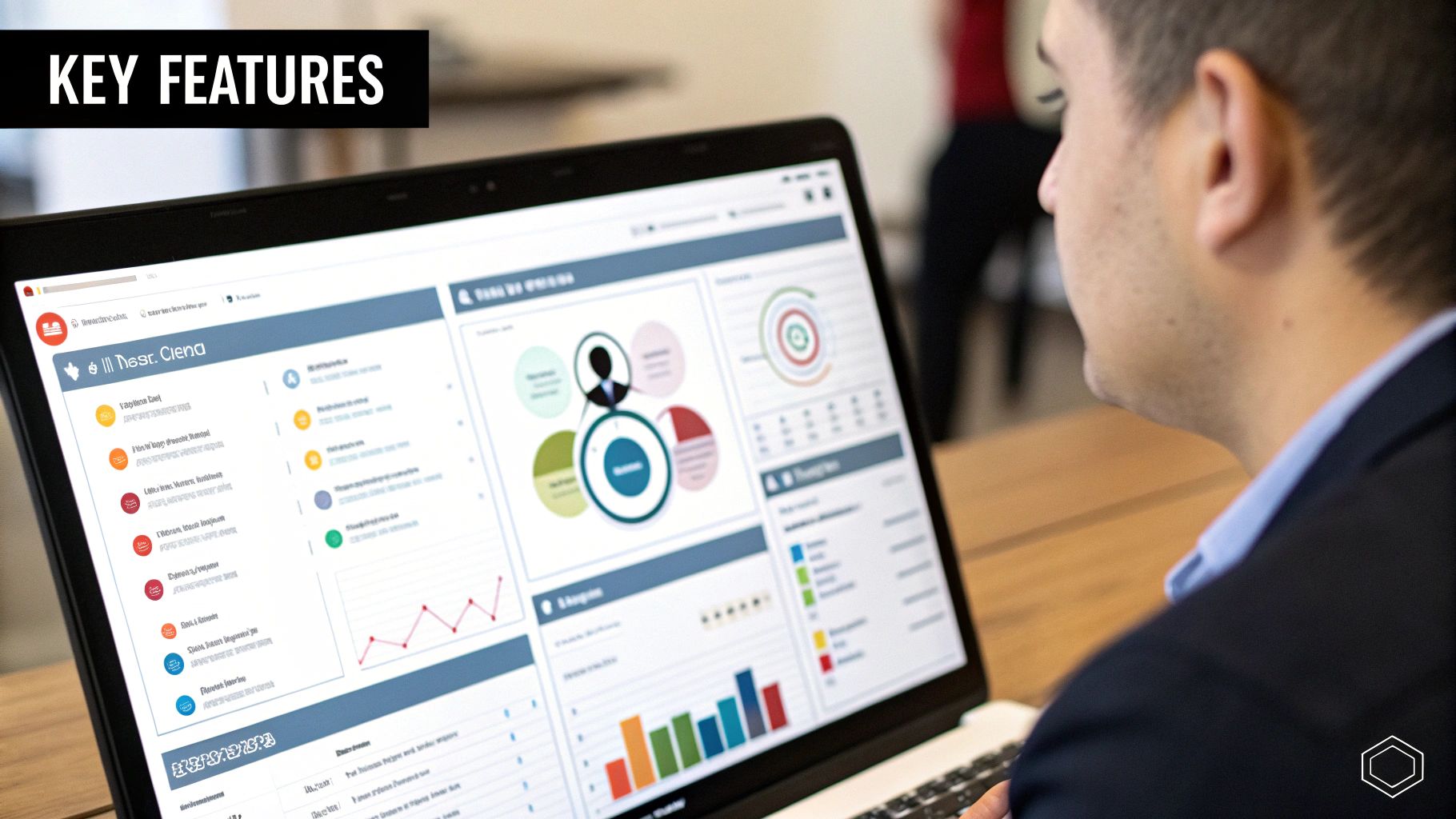In today’s cutthroat job market, just waiting for the right candidates to show up is a recipe for failure. This is where candidate sourcing tools come in. Think of them as specialised software that flips your recruitment from a passive waiting game to a proactive hunt. They give your recruiters the power to actively search for, identify, and engage top talent—especially those who aren’t even looking for a new job.
Winning the War for Talent with Modern Sourcing Tools
Picture a traditional recruiter: they’re a bit like a shopkeeper, setting up their stall (a job ad) and hoping the perfect customer walks through the door. Now, imagine a skilled detective, actively following clues and uncovering hidden leads. That’s the fundamental shift candidate sourcing tools bring to the table. They let your team break free from the limits of inbound applications and build a real strategic advantage.
Instead of just sorting through who applies, these platforms allow you to go on the offensive, hunting for talent across a huge digital landscape. You can pinpoint professionals with niche skills on platforms like LinkedIn, discover experts through their published work, and spot promising individuals in specialised online communities.
Moving From Reactive to Proactive Recruitment
Why is this proactive approach so critical? A few key reasons stand out:
- Accessing Passive Talent: Let’s be honest, the most talented people are often happily employed and not scrolling through job boards. Sourcing tools are your direct line to this hidden talent pool.
- Building a Strategic Pipeline: You can build and nurture relationships with high-potential candidates long before a role even opens up. This drastically cuts down your time-to-fill when you actually need to hire.
- Gaining a Competitive Edge: While your competitors are waiting for applications to trickle in, you’re out there mapping the market and engaging the best people, making sure you’re the first one they talk to.
The real magic of sourcing technology is how it transforms recruitment. It shifts it from a transactional function—just filling empty seats—into a strategic one focused on building the very future of your organisation’s workforce.
This infographic paints a clear picture of what this modern, proactive talent hunt looks like in a complex digital world.

It really highlights how recruiters can now act like digital detectives, using these tools to piece together data from all over the web to find that perfect fit.
The Growing Importance of Sourcing Technology
The rush to adopt these platforms isn’t just a fleeting trend; it’s a direct response to a changing market. The Indian recruitment software market, which includes a wide variety of candidate sourcing tools, was valued at a hefty USD 88.82 million in 2024. This sector is expected to grow significantly, proving just how vital technology has become in hiring. For a deeper look at this trend, you can get more insights on the recruitment software market from Expert Market Research.
This level of investment highlights a crucial reality: companies are betting on technology to find and secure top talent more effectively. For CHROs, this means embracing tools that don’t just save time but fundamentally improve the quality of every single hire. To get started, it helps to understand the foundational strategies that make these tools so powerful. Take a look at our guide on the best candidate sourcing practices for tech hiring to build a strong foundation.
Here is the rewritten section, crafted to sound completely human-written and natural, following all your specified requirements.
Navigating the Different Types of Sourcing Tools
The world of candidate sourcing tools isn’t a one-size-fits-all market. Think of it like a mechanic’s toolbox; you wouldn’t use a hammer to change a tyre. Each tool is designed for a specific job, and understanding what makes them different is the first step toward building a truly effective talent acquisition machine.
Instead of getting bogged down in jargon, let’s break down the main categories of tools you’ll come across. We’ll look at what each one does best, the specific problem it solves, and when you should reach for it. This way, you can start mapping your own needs to the right technology.
Applicant Tracking Systems with Sourcing Features
At its core, an Applicant Tracking System (ATS) is your digital filing cabinet. It’s the central hub for managing all your inbound applications, keeping resumes from your careers page and job board postings neatly organised. But today’s best ATS platforms do much more than just store data.
Many now come with powerful, built-in sourcing features. This allows your recruiters to actively search their existing database of past applicants for potential matches for new roles. For example, a candidate who was a fantastic fit but just missed out on a role six months ago can be instantly rediscovered. This simple function transforms your ATS from a passive storage unit into a proactive, private talent pool.
- Core Function: Managing active applicants and rediscovering past candidates within your own database.
- Ideal Scenario: Perfect for organisations looking to maximise the value of their existing talent pool and keep recruitment activities under one roof.
- Problem Solved: It stops you from losing valuable candidates who have already shown interest in your company, making every search more efficient.
Dedicated Sourcing Platforms
While an ATS primarily looks inward, dedicated sourcing platforms look outward. These are the powerhouse search engines of the recruitment world, built to scan the vast expanse of the open web for potential candidates. They pull together data from professional networks, social media profiles, public records, and online portfolios.
Think of these tools as your digital headhunters. They use advanced search filters to help you pinpoint people with highly specific skills, especially those “passive” candidates who aren’t actively looking for a job. A recruiter searching for a rare “machine learning engineer with experience in the Indian fintech sector” would turn to a dedicated platform to find them.
These platforms are designed for proactive talent hunting. They empower recruiters to build talent maps, understand a competitor’s talent landscape, and engage with professionals who would otherwise be completely invisible.
Social Media Aggregators
Social media aggregators are a more specialised type of candidate sourcing tool. They focus entirely on social and professional networks, going far beyond a simple search on LinkedIn. They pull together profiles and activity from multiple sites like GitHub for developers, Behance for designers, or even academic platforms for researchers.
This gives you a much richer, more complete picture of a candidate. You might see their professional history on one site and their portfolio of real work on another, all within a single interface. This is absolutely critical for roles where a portfolio or public contribution is just as important as a traditional CV.
AI Talent Intelligence Systems
This is the most advanced category and a real glimpse into the future of talent acquisition. AI talent intelligence systems don’t just find people; they deliver deep insights and predictive analytics. These platforms use artificial intelligence to analyse market trends, predict hiring challenges, and even identify which passive candidates are most likely to be open to a new opportunity right now.
They can enrich candidate profiles with data from dozens of sources, verify contact information, and automate personalised outreach campaigns at scale. For a CHRO, these systems offer a massive strategic advantage, shifting recruitment from a reactive function to a data-driven, business intelligence operation.
To help you visualise how these tools fit together, here’s a quick comparison of the main categories.
Comparing Candidate Sourcing Tool Categories
The table below breaks down the primary types of sourcing tools, outlining what they do and the scenarios where they deliver the most value for recruitment teams.
| Tool Category | Primary Function | Best For |
|---|---|---|
| ATS with Sourcing | Managing inbound applicants & searching an internal database. | Teams wanting to consolidate tasks and leverage past applicants. |
| Dedicated Sourcing Platform | Proactively searching the open web for passive talent. | Recruiters focused on hard-to-fill roles and competitive intelligence. |
| Social Media Aggregator | Consolidating profiles from various social networks. | Hiring for creative or technical roles where portfolios are key. |
| AI Talent Intelligence | Providing predictive insights and automating outreach. | Strategic TA functions aiming to build a data-driven hiring engine. |
Understanding these distinctions is the foundation for choosing the right technology. Each category serves a unique purpose, and you’ll find that the most successful recruitment strategies often use a smart combination of these powerful tools.
How AI Is Revolutionising Candidate Sourcing
Artificial Intelligence isn’t just a concept from a sci-fi movie anymore; it’s a real, practical co-pilot for today’s recruitment teams. Don’t think of AI in sourcing as a replacement for your recruiters. Instead, picture it as a force multiplier. It shoulders the burden of repetitive, data-heavy work that eats up precious time, freeing your team to do what humans do best: build relationships and make insightful hiring decisions.
Think of AI-powered candidate sourcing tools as a hyper-efficient research assistant. They can sift through millions of profiles, CVs, and digital footprints in seconds—a task that would take a human recruiter weeks to even attempt. This isn’t just about speeding up keyword searches; it’s about fundamentally changing the sourcing workflow from the ground up.

This shift isn’t coming; it’s already here. In India, AI adoption in sourcing is practically universal. A recent survey showed that a staggering 87.9% of recruiters in India’s Global Capability Centres (GCCs) are already using AI for sourcing. The results speak for themselves: 75% of these recruiters report significantly faster screening, and 59% see better candidate-job matching. You can dive deeper into how AI is reshaping the hiring landscape by reviewing the market findings.
Unlocking Deeper Talent Pools with Semantic Search
Old-school sourcing often hinged on exact keyword matches. If your job description called for a “Content Marketer” but a stellar candidate’s profile listed “Content Strategist,” a basic search would probably miss them. This is where AI-driven semantic search changes the game. It understands context, not just words.
It grasps that “Content Strategist,” “Brand Storyteller,” and “Content Marketer” are related roles with similar skill sets. This allows the tool to surface top-tier candidates who would otherwise stay hidden, massively expanding the quality of your talent pool. It’s the difference between searching a library catalogue for one specific title and asking the head librarian to find you the best books on a topic.
Automating the Tedious and Time-Sucking Tasks
One of the most immediate benefits of AI is its knack for handling the high-volume, low-complexity work that bogs recruiters down. Think about the countless hours spent manually sifting through CVs—a process that’s not only mind-numbing but also prone to human error. AI sourcing tools can take over this initial screening with incredible speed and accuracy.
Here’s how AI gets it done:
- CV Parsing: It instantly pulls and organises key information from any CV, no matter the format, into a neat, structured profile.
- Automated Screening: It ranks candidates based on how well their skills and background truly align with your job requirements.
- Profile Enrichment: It gathers publicly available data from across the web to build a richer, more complete picture of each candidate.
This level of automation ensures your team connects only with the most promising individuals right from the start. The result? A faster hiring cycle and a much better experience for every candidate.
By handing off repetitive work to AI, you empower your recruitment team to function at a higher, more strategic level. They can stop drowning in data and start engaging in meaningful conversations with top talent.
Predicting Candidate Intent and Reducing Bias
The most sophisticated AI sourcing platforms are now venturing into predictive analytics. These systems analyse subtle digital cues—like a recently updated professional profile, a new online certification, or a flurry of network activity—to predict which passive candidates are warming up to the idea of a new role. This gives your team the intel they need to time their outreach for maximum impact.
What’s more, when implemented thoughtfully, AI can be a powerful ally in the fight against unconscious bias. By focusing purely on the skills, experience, and qualifications laid out in the job criteria, AI algorithms can present a more diverse slate of candidates. This helps ensure everyone gets a fair shot, regardless of their background. Of course, it’s crucial to regularly audit these systems to ensure they aren’t accidentally learning and repeating existing biases, turning a tool for fairness into one that perpetuates the status quo.
Must-Have Features in a Sourcing Platform

Trying to choose the right candidate sourcing tool can feel like wading through a sea of technical jargon and endless feature lists. It’s easy to get lost.
To cut through the noise, you have to separate the nice-to-haves from the absolute essentials. The best platforms aren’t just about cramming in the most features; they’re about having the right features that actually make a difference for your recruitment team.
Let’s break down the non-negotiable capabilities a modern sourcing platform needs to have. We’ll go beyond the marketing fluff and look at what each feature really means for your team’s day-to-day work and your company’s long-term talent strategy.
Advanced Search and Filtering Capabilities
At its core, a sourcing tool is a search engine for people. Its ability to find the precise talent you need is everything. A basic keyword search just doesn’t cut it anymore in a world of diverse job titles and nuanced skills.
Your platform absolutely must offer advanced Boolean search. This lets recruiters build super-specific search strings using operators like AND, OR, and NOT to combine keywords, titles, and skills. It’s the difference between a targeted search and just throwing darts in the dark, ensuring your team spends time on truly relevant profiles.
Beyond that, look for sophisticated filtering options that go way beyond location and job title. Essential filters should include:
- Skills and Competencies: The power to filter for specific programming languages, software proficiency, or even soft skills.
- Years of Experience: To zero in on candidates at the exact right seniority level.
- Industry Background: To focus on talent with experience in your sector.
- Company History: For identifying candidates from competitor organisations or specific types of companies.
These advanced search tools are the bedrock of effective sourcing. They have a direct impact on the quality of candidates you find right from the start.
Seamless Integration with Your HR Tech Stack
A sourcing tool that operates in its own little bubble creates more problems than it solves. It leads to data silos, duplicated work, and a clunky, frustrating workflow for your recruiters. That’s why smooth integration with your existing HR tech—especially your Applicant Tracking System (ATS)—is a critical must-have.
This integration needs to be deep and two-way. When a recruiter finds a great candidate, they should be able to send that profile to your ATS with a single click. Just as importantly, the tool should be able to check your ATS to make sure you aren’t about to contact someone who’s already in the pipeline.
A well-integrated system creates a single source of truth for all candidate data. This not only saves an incredible amount of admin time but also gives you a complete picture of your talent pipeline, from first contact to final hire.
Robust Analytics and Reporting Dashboards
Let’s be blunt: you can’t improve what you don’t measure. A top-tier sourcing platform has to give you clear, actionable insights into your team’s performance and the health of your talent pipeline. For any data-driven recruitment leader, a solid analytics dashboard is non-negotiable.
These dashboards should track the key performance indicators (KPIs) that actually matter, such as:
- Source of Hire: Which channels are really delivering the best candidates?
- Response Rates: How effective are your outreach emails and messages?
- Time-to-Source: How long does it take to build a qualified shortlist for a role?
- Diversity Metrics: Are you building the diverse, inclusive talent pipeline you need?
Good data empowers you to make smarter strategic decisions, allocate your resources where they’ll have the most impact, and clearly demonstrate the ROI of your sourcing efforts. A platform’s ability to ease digital hiring often comes down to its power to provide simple, understandable data.
To make this clearer, here’s a quick checklist of the features you should be looking for and the tangible benefits they bring.
Essential Features Checklist for Sourcing Tools
| Feature | Primary Benefit | Impact on Recruitment KPIs |
|---|---|---|
| Advanced Boolean Search | Pinpoint exact candidate profiles | Improves Quality of Hire, Reduces Time-to-Fill |
| Sophisticated Skill Filters | Target niche and hard-to-find talent | Increases Candidate Relevance, Lowers Sourcing Time |
| Deep ATS Integration | Creates a single source of truth for data | Reduces Admin Time, Improves Candidate Experience |
| Automated Data Sync | Prevents duplicate entries and outreach | Enhances Recruiter Productivity, Improves Data Accuracy |
| Source of Hire Analytics | Optimises channel spend and strategy | Lowers Cost-per-Hire, Increases Conversion Rates |
| Team Performance Dashboards | Monitors recruiter activity and effectiveness | Boosts Team Productivity, Identifies Training Needs |
| Shared Talent Pools | Centralises candidate info for collaboration | Speeds Up Sourcing, Improves Internal Mobility |
| In-Platform Messaging/Notes | Streamlines communication with hiring managers | Reduces Decision Time, Improves Stakeholder Alignment |
This table serves as a quick reference guide. When evaluating a tool, if it doesn’t tick most of these boxes, it’s probably not the right fit for a modern, results-driven talent acquisition team.
Built-in Collaboration and Communication Tools
Sourcing is rarely a one-person show. Recruiters, sourcers, and hiring managers all need to work together without friction. Your chosen platform should make this teamwork easy with built-in collaboration tools.
This means features like shared projects or talent pools, the ability to @mention colleagues in notes on a candidate’s profile, and shared templates for outreach messages. These tools get everyone on the same page, cut down on the endless back-and-forth emails, and speed up the entire decision-making process. By centralising communication, you build a much more efficient and coordinated sourcing engine.
Choosing the Right Candidate Sourcing Tool
Picking the perfect sourcing tool from a packed market can feel like a mammoth task. But with a bit of a structured approach, you can turn a complicated decision into a clear, strategic one. It’s not about chasing the tool with the longest list of features; it’s about finding the one that actually solves your team’s specific problems and helps you hit your goals.
Your first step? A deep dive into your own recruitment process. Before you even glance at a single vendor’s website, you need to get brutally honest about your team’s pain points. Are your recruiters burning hours on manual searches? Are you pulling your hair out trying to find candidates with niche skills? Is your data a chaotic mess spread across endless spreadsheets and inboxes?
By getting specific about these challenges, you’re creating a clear problem statement. This becomes the very foundation of your evaluation, making sure you’re solving real issues, not just buying shiny new tech for the sake of it.
Define Your Budget and Scalability Needs
Once you know what you need, it’s time to bring it back to reality. What’s your budget, and where do you see the company going? It’s so important to think beyond just the initial licence fee. You need to consider the total cost of ownership—that means factoring in implementation, training for your team, and any ongoing support costs.
At the same time, think about the future. Do you expect your hiring volume to jump in the next couple of years? Are you planning to expand into new markets or territories? A tool that feels like a perfect fit today might feel completely restrictive tomorrow.
Choosing a candidate sourcing tool with scalability in mind means it can grow with your business. This prevents a costly and disruptive switch just a short way down the line. It’s a strategic move that balances what you need right now with where you’re heading.
Run Effective Vendor Demos with a Scorecard
Vendor demos are your chance to see these tools in the wild, but they can easily turn into passive sales pitches if you’re not careful. To get real value, you need to take control. Arm yourself with a list of real-world scenarios based on the pain points you already identified. Then, ask each vendor to show you exactly how their platform solves them.
To keep your evaluation objective and fair, create a simple evaluation scorecard. This should list all your must-have features and key criteria, allowing your team to rate each vendor consistently.
This structured approach helps you compare platforms on a level playing field. You can cut through the flashy presentations and focus on what the tool can actually do for you. Getting your recruiters involved in this process is also a game-changer for getting their buy-in and making sure the tool actually gets used.
A classic mistake is picking a tool based on what looks impressive rather than what your team will realistically use. A powerful, feature-loaded platform is completely useless if it’s too complicated for your recruiters to fit into their day-to-day work.
All-in-One Suite vs Best-of-Breed Platform
One of the big strategic choices you’ll face is whether to go for an all-in-one HR suite that includes sourcing or a specialised, best-of-breed sourcing platform. An all-in-one system offers the simplicity of having everything under one roof, which can make data management a breeze. The downside? Its sourcing module might not have the powerful, advanced features of a dedicated tool.
On the other hand, a best-of-breed platform gives you deep, specialised functionality but will need careful integration with the rest of your HR tech. There’s no single right answer here. The best choice really depends on your company’s priorities, what systems you already have, and how complex your sourcing needs are. Many organisations are even finding success with a hybrid model.
This decision can also be influenced by whether you handle sourcing in-house or with a partner. Outsourcing candidate sourcing to India, for example, is a major trend, especially with the country’s massive IT outsourcing sector hitting USD 585.57 billion in 2023. Companies are tapping into this to find local expertise and advanced sourcing tech to beat skills shortages. You can discover more insights about why India leads in outsourced recruitment on qxglobalgroup.com. This could change whether you need an in-house tool or one that supports an outsourced partnership model.
Implementing Your Tool for Maximum Impact
Getting your hands on powerful candidate sourcing tools is a brilliant start, but it’s really only half the job done. Think of it like buying a high-performance race car; it has all the potential in the world, but it won’t win a single race without a skilled driver, a trained pit crew, and a clear strategy. Unlocking the real value of your investment comes down to how well you integrate it into your organisation.
A great tool needs a great implementation plan to deliver those game-changing results. This is about more than just a simple software rollout. You need to focus on three critical pillars: your data, your people, and your process. Get these right, and your new platform will become an indispensable asset, not just an expensive, underused gadget.
Laying the Foundation with Data Migration
Your first technical hurdle is always data migration. This is the process of moving all your existing candidate profiles, past applicant data, and talent pipelines from the old systems into the new one. A clean, well-organised data transfer is absolutely essential if you want to hit the ground running and make the tool effective from day one.
A sloppy migration can mean lost information, duplicate profiles, and seriously frustrated recruiters. You’ll need to work closely with your vendor to plan this stage carefully, ensuring every bit of valuable historical data is preserved and structured correctly within the new platform. This is what turns your tool into a rich, internal talent database right from the start.
Empowering Your Team with Effective Training
Just giving your recruiters access to a new tool and hoping for the best is a recipe for failure. Effective, hands-on training isn’t just a nice-to-have; it’s non-negotiable for driving adoption and getting a strong return on your investment. This training has to go beyond just showing people which buttons to click.
It needs to focus on the “why” behind the features, demonstrating exactly how the tool solves their daily headaches and helps them hit their targets faster.
The goal of training isn’t just to teach functionality; it’s to build confidence. When your team feels competent and sees how the tool makes their jobs easier, they will naturally embrace it as part of their daily workflow.
Redefining Workflows and Measuring Success
A new tool demands new ways of working. It’s crucial to develop and document clear Standard Operating Procedures (SOPs) that properly embed the platform into your sourcing process. This creates consistency across the team and ensures everyone is using the tool to its full potential. To get a better sense of how technology can reshape your hiring workflows, take a look at our guide covering the 7 steps for digital hiring using recruitment technology.
Finally, you have to measure what matters. Establish clear Key Performance Indicators (KPIs) to track the platform’s impact. These metrics give you the concrete proof you need to show ROI.
- Time-to-Fill: A noticeable reduction in the time it takes to fill open roles.
- Qualified Candidates per Role: An increase in the number of high-quality candidates being presented to hiring managers.
- Hiring Manager Satisfaction: Improved feedback on candidate quality and the efficiency of the whole process.
By focusing on these areas, you ensure your new candidate sourcing tool doesn’t just get implemented—it gets embedded, optimised, and delivers the maximum possible impact.
Ready to transform your talent acquisition from a reactive function into a proactive, strategic powerhouse?At Taggd, we specialise in building high-performance recruitment engines. Discover how our expertise can help you find and engage the talent you need to win.







